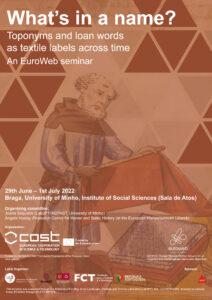
EuroWeb Seminar – “What’s in a name? Toponyms and loan words as textile labels across time”, Braga, PT
What’s in a name?
Toponyms and loan words as textile labels across time. An EuroWeb seminar.
29th June – 1st July 2022
ON SITE @ ICS, University of Minho, Braga (Portugal)
Organisers:
Joana Sequeira, Lab2PT/INT2PAST, Universidade do Minho
Angela Huang, Research Centre for Hanse and Baltic History (at the European Hansemuseum Lübeck)
Textiles as man-made products have been exchanged over distances for millennia. This brings with it naming practices to communicate about the characteristics of the items in question. Textiles are labelled so that people can form expectations about them and rely on the reputation tied to the products identity. Terminology of textiles and textile items in exchange arises and develops in unison with technical innovations, discoveries, fashions and trade patterns.
There are two major naming practices we find over time and space: toponyms and loan words. Toponyms on the one hand refer to the place of production, purchase or trade; they connect textile items to places that guarantee a given quality. Toponyms stand for a wide range of characteristics: measurements, density, design, raw material, general product type and price – to name the most common ones. Some toponyms became widely known and inspired others to follow in their step: Leiden cloth, Arras, muslin (Mosul), damask and denim are famous examples that were imitated and became models.
Loan words on the other hand testify to fashion innovations that were widely adapted. In difference to toponyms, they also include clothing. Kimono and pyjamas are two well-known loan words present in today’s language. Loan words refer to cultural transfer of textile traditions.
We will discuss and discover the many meanings of toponyms and loan words in greater detail at our seminar, organised within the scope of WG3 (Textile and Clothing Terminologies Group) of EuroWeb COST Action (CA 19131). We are inviting case studies dealing with these kinds of textile labelling practices, from antiquity to the 20th century. We are not limited to a given geographical area.
Specifically, we invite you to discuss:
- Brand/ branding strategies associated with the names of textile items
- Fakes/ imitations
- Adaptation and distortion of labels in different languages
- Meaning attached to toponyms and loanwords
The full programme of the Seminar is now available and can be consulted here.

What’s in a name?
Toponyms and loan words as textile labels across time. An EuroWeb seminar.
29th June – 1st July 2022
ON SITE @ ICS, University of Minho, Braga (Portugal)
Organisers:
Joana Sequeira, Lab2PT/INT2PAST, Universidade do Minho
Angela Huang, Research Centre for Hanse and Baltic History (at the European Hansemuseum Lübeck)
Textiles as man-made products have been exchanged over distances for millennia. This brings with it naming practices to communicate about the characteristics of the items in question. Textiles are labelled so that people can form expectations about them and rely on the reputation tied to the products identity. Terminology of textiles and textile items in exchange arises and develops in unison with technical innovations, discoveries, fashions and trade patterns.
There are two major naming practices we find over time and space: toponyms and loan words. Toponyms on the one hand refer to the place of production, purchase or trade; they connect textile items to places that guarantee a given quality. Toponyms stand for a wide range of characteristics: measurements, density, design, raw material, general product type and price – to name the most common ones. Some toponyms became widely known and inspired others to follow in their step: Leiden cloth, Arras, muslin (Mosul), damask and denim are famous examples that were imitated and became models.
Loan words on the other hand testify to fashion innovations that were widely adapted. In difference to toponyms, they also include clothing. Kimono and pyjamas are two well-known loan words present in today’s language. Loan words refer to cultural transfer of textile traditions.
We will discuss and discover the many meanings of toponyms and loan words in greater detail at our seminar, organised within the scope of WG3 (Textile and Clothing Terminologies Group) of EuroWeb COST Action (CA 19131). We are inviting case studies dealing with these kinds of textile labelling practices, from antiquity to the 20th century. We are not limited to a given geographical area.
Specifically, we invite you to discuss:
- Brand/ branding strategies associated with the names of textile items
- Fakes/ imitations
- Adaptation and distortion of labels in different languages
- Meaning attached to toponyms and loanwords
The full programme of the Seminar is now available and can be consulted here.
